BTEC HND in Civil Engineering: Engineering Geology & Soil Mechanics
VerifiedAdded on 2021/06/17
|20
|3897
|286
Report
AI Summary
This report, prepared for the BTEC HND in Civil Engineering module on Engineering Geology & Soil Mechanics, explores the fundamental concepts of rock types and soil mechanics. The assignment begins with an acknowledgement and introduction, setting the stage for an in-depth examination of sedimentary, igneous, and metamorphic rocks. It details the formation, characteristics, and classification of these rock types, including clastic, biological, and chemical sedimentary rocks. The report further delves into the weathering of rock-forming minerals, categorizing them based on their atmospheric stability and susceptibility to weathering. Finally, the report discusses the common uses of rocks in construction, providing practical insights for civil engineering applications. The report includes detailed descriptions, classifications, and examples of various rock types and their properties. This assignment aims to provide a comprehensive understanding of the fundamental concepts of rock types and soil mechanics. The assignment covers the identification and classification of various rock types and the understanding of their properties. The report includes detailed descriptions, classifications, and examples of various rock types and their properties.

Engineering Geology & Soil Mechanics
Assignment 01:
Understand the common rock types, classification of soil types and establishment of the
primary design parameters for soils.
Assignment 01:
Understand the common rock types, classification of soil types and establishment of the
primary design parameters for soils.
Paraphrase This Document
Need a fresh take? Get an instant paraphrase of this document with our AI Paraphraser

BTEC HND in Civil
Engineering
Acknowledgement
I take this opportunity to thank and appreciate Miss. Sushama De Silva, guiding
me throughout this Engineering Geology & Soil Mechanics Module and helping me with all his
experiences and knowledge by being a brilliant teacher in this second semester. Stories, working
tricks and teaching rhythm always makes me more interested and knowledgeable about this
module.
Engineering Geology & Soil Mechanics Page 1
Engineering
Acknowledgement
I take this opportunity to thank and appreciate Miss. Sushama De Silva, guiding
me throughout this Engineering Geology & Soil Mechanics Module and helping me with all his
experiences and knowledge by being a brilliant teacher in this second semester. Stories, working
tricks and teaching rhythm always makes me more interested and knowledgeable about this
module.
Engineering Geology & Soil Mechanics Page 1
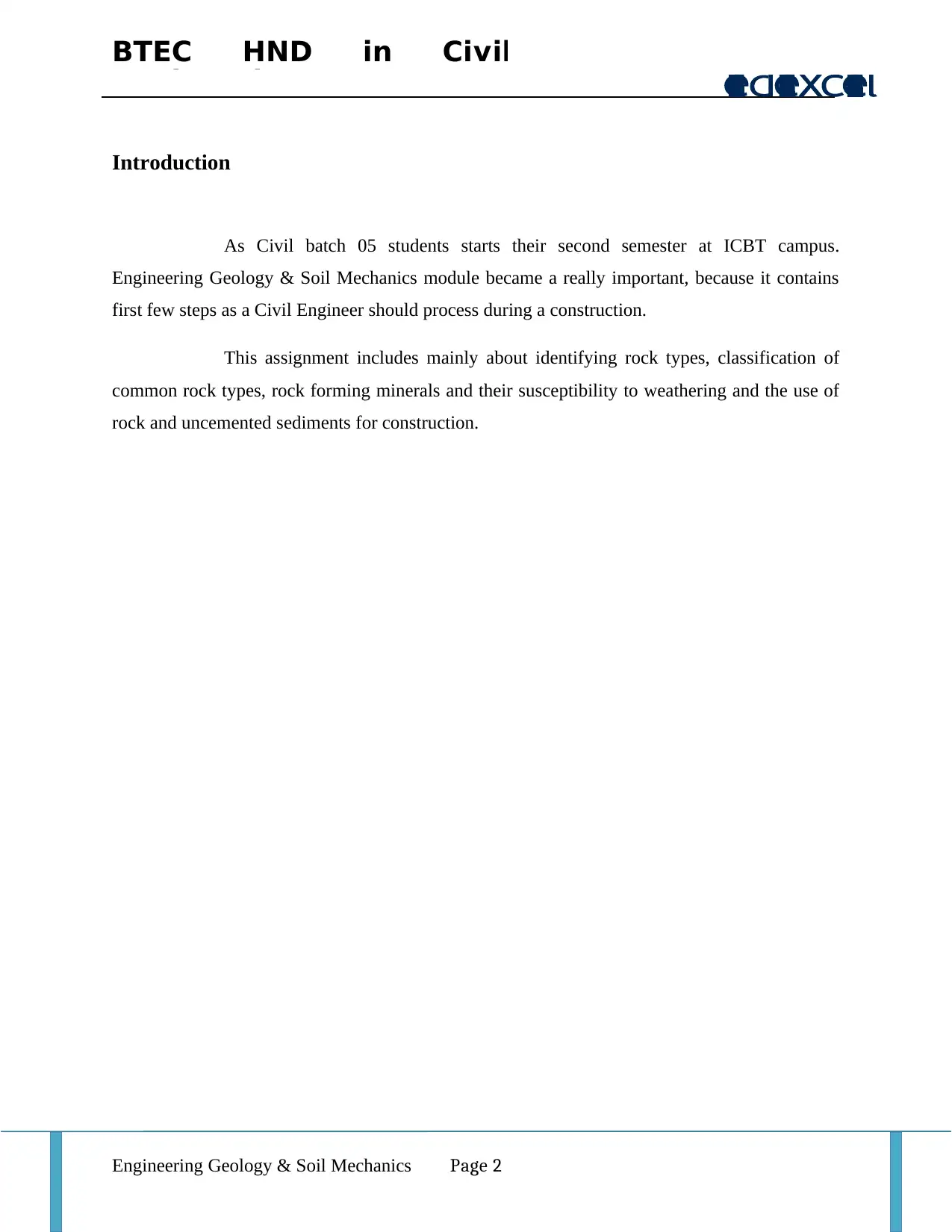
BTEC HND in Civil
Engineering
Introduction
As Civil batch 05 students starts their second semester at ICBT campus.
Engineering Geology & Soil Mechanics module became a really important, because it contains
first few steps as a Civil Engineer should process during a construction.
This assignment includes mainly about identifying rock types, classification of
common rock types, rock forming minerals and their susceptibility to weathering and the use of
rock and uncemented sediments for construction.
Engineering Geology & Soil Mechanics Page 2
Engineering
Introduction
As Civil batch 05 students starts their second semester at ICBT campus.
Engineering Geology & Soil Mechanics module became a really important, because it contains
first few steps as a Civil Engineer should process during a construction.
This assignment includes mainly about identifying rock types, classification of
common rock types, rock forming minerals and their susceptibility to weathering and the use of
rock and uncemented sediments for construction.
Engineering Geology & Soil Mechanics Page 2
⊘ This is a preview!⊘
Do you want full access?
Subscribe today to unlock all pages.

Trusted by 1+ million students worldwide
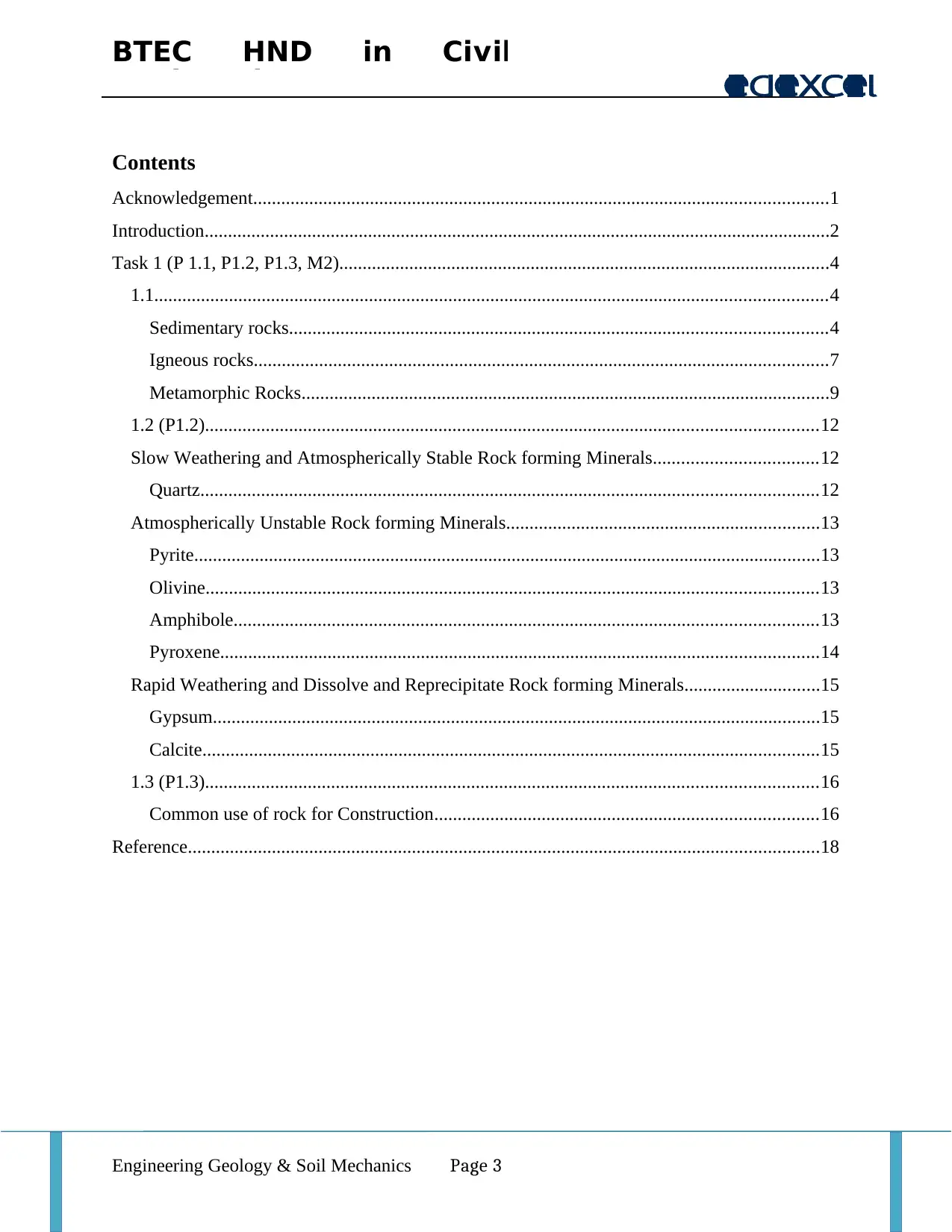
BTEC HND in Civil
Engineering
Contents
Acknowledgement...........................................................................................................................1
Introduction......................................................................................................................................2
Task 1 (P 1.1, P1.2, P1.3, M2).........................................................................................................4
1.1................................................................................................................................................4
Sedimentary rocks...................................................................................................................4
Igneous rocks...........................................................................................................................7
Metamorphic Rocks.................................................................................................................9
1.2 (P1.2)...................................................................................................................................12
Slow Weathering and Atmospherically Stable Rock forming Minerals...................................12
Quartz....................................................................................................................................12
Atmospherically Unstable Rock forming Minerals...................................................................13
Pyrite......................................................................................................................................13
Olivine...................................................................................................................................13
Amphibole.............................................................................................................................13
Pyroxene................................................................................................................................14
Rapid Weathering and Dissolve and Reprecipitate Rock forming Minerals.............................15
Gypsum..................................................................................................................................15
Calcite....................................................................................................................................15
1.3 (P1.3)...................................................................................................................................16
Common use of rock for Construction..................................................................................16
Reference.......................................................................................................................................18
Engineering Geology & Soil Mechanics Page 3
Engineering
Contents
Acknowledgement...........................................................................................................................1
Introduction......................................................................................................................................2
Task 1 (P 1.1, P1.2, P1.3, M2).........................................................................................................4
1.1................................................................................................................................................4
Sedimentary rocks...................................................................................................................4
Igneous rocks...........................................................................................................................7
Metamorphic Rocks.................................................................................................................9
1.2 (P1.2)...................................................................................................................................12
Slow Weathering and Atmospherically Stable Rock forming Minerals...................................12
Quartz....................................................................................................................................12
Atmospherically Unstable Rock forming Minerals...................................................................13
Pyrite......................................................................................................................................13
Olivine...................................................................................................................................13
Amphibole.............................................................................................................................13
Pyroxene................................................................................................................................14
Rapid Weathering and Dissolve and Reprecipitate Rock forming Minerals.............................15
Gypsum..................................................................................................................................15
Calcite....................................................................................................................................15
1.3 (P1.3)...................................................................................................................................16
Common use of rock for Construction..................................................................................16
Reference.......................................................................................................................................18
Engineering Geology & Soil Mechanics Page 3
Paraphrase This Document
Need a fresh take? Get an instant paraphrase of this document with our AI Paraphraser
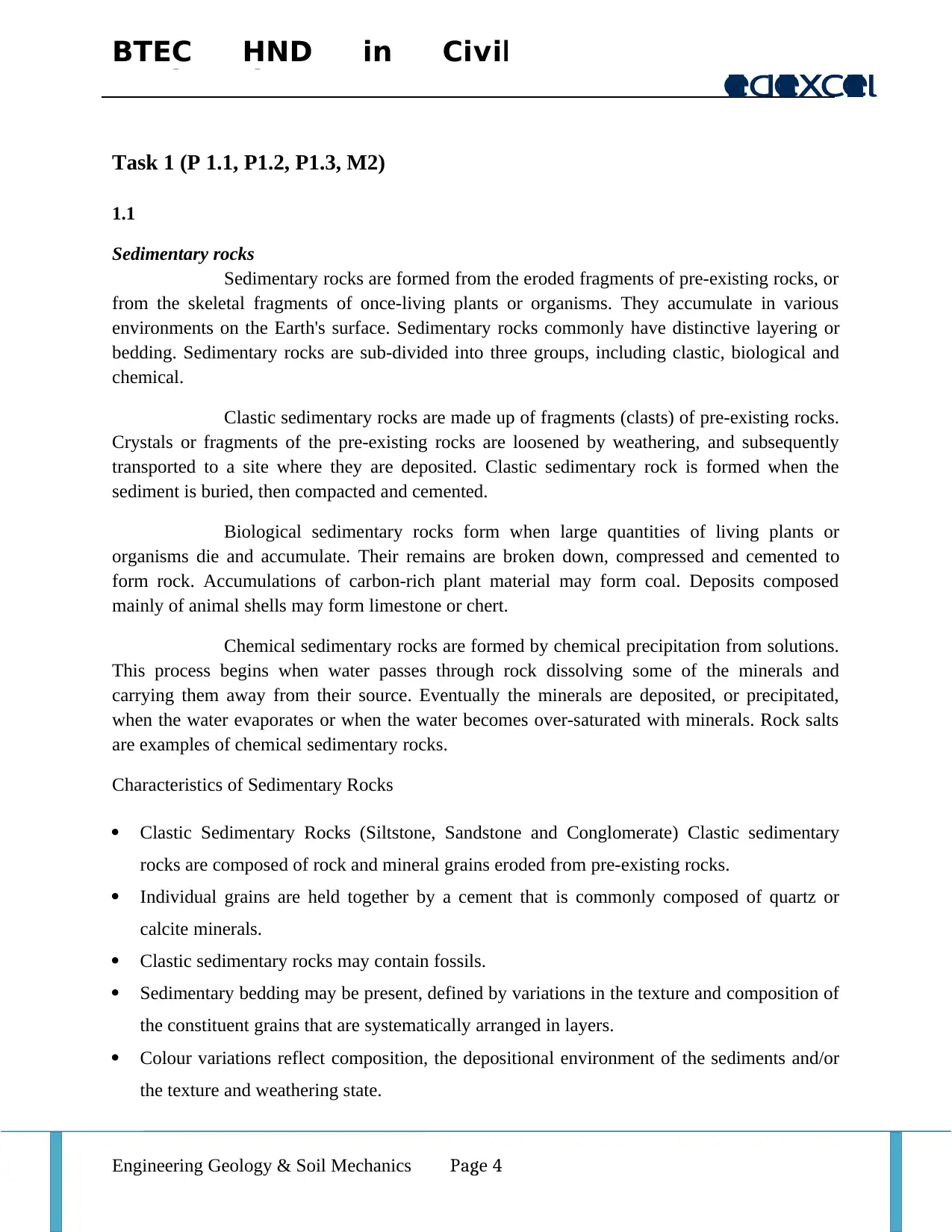
BTEC HND in Civil
Engineering
Task 1 (P 1.1, P1.2, P1.3, M2)
1.1
Sedimentary rocks
Sedimentary rocks are formed from the eroded fragments of pre-existing rocks, or
from the skeletal fragments of once-living plants or organisms. They accumulate in various
environments on the Earth's surface. Sedimentary rocks commonly have distinctive layering or
bedding. Sedimentary rocks are sub-divided into three groups, including clastic, biological and
chemical.
Clastic sedimentary rocks are made up of fragments (clasts) of pre-existing rocks.
Crystals or fragments of the pre-existing rocks are loosened by weathering, and subsequently
transported to a site where they are deposited. Clastic sedimentary rock is formed when the
sediment is buried, then compacted and cemented.
Biological sedimentary rocks form when large quantities of living plants or
organisms die and accumulate. Their remains are broken down, compressed and cemented to
form rock. Accumulations of carbon-rich plant material may form coal. Deposits composed
mainly of animal shells may form limestone or chert.
Chemical sedimentary rocks are formed by chemical precipitation from solutions.
This process begins when water passes through rock dissolving some of the minerals and
carrying them away from their source. Eventually the minerals are deposited, or precipitated,
when the water evaporates or when the water becomes over-saturated with minerals. Rock salts
are examples of chemical sedimentary rocks.
Characteristics of Sedimentary Rocks
Clastic Sedimentary Rocks (Siltstone, Sandstone and Conglomerate) Clastic sedimentary
rocks are composed of rock and mineral grains eroded from pre-existing rocks.
Individual grains are held together by a cement that is commonly composed of quartz or
calcite minerals.
Clastic sedimentary rocks may contain fossils.
Sedimentary bedding may be present, defined by variations in the texture and composition of
the constituent grains that are systematically arranged in layers.
Colour variations reflect composition, the depositional environment of the sediments and/or
the texture and weathering state.
Engineering Geology & Soil Mechanics Page 4
Engineering
Task 1 (P 1.1, P1.2, P1.3, M2)
1.1
Sedimentary rocks
Sedimentary rocks are formed from the eroded fragments of pre-existing rocks, or
from the skeletal fragments of once-living plants or organisms. They accumulate in various
environments on the Earth's surface. Sedimentary rocks commonly have distinctive layering or
bedding. Sedimentary rocks are sub-divided into three groups, including clastic, biological and
chemical.
Clastic sedimentary rocks are made up of fragments (clasts) of pre-existing rocks.
Crystals or fragments of the pre-existing rocks are loosened by weathering, and subsequently
transported to a site where they are deposited. Clastic sedimentary rock is formed when the
sediment is buried, then compacted and cemented.
Biological sedimentary rocks form when large quantities of living plants or
organisms die and accumulate. Their remains are broken down, compressed and cemented to
form rock. Accumulations of carbon-rich plant material may form coal. Deposits composed
mainly of animal shells may form limestone or chert.
Chemical sedimentary rocks are formed by chemical precipitation from solutions.
This process begins when water passes through rock dissolving some of the minerals and
carrying them away from their source. Eventually the minerals are deposited, or precipitated,
when the water evaporates or when the water becomes over-saturated with minerals. Rock salts
are examples of chemical sedimentary rocks.
Characteristics of Sedimentary Rocks
Clastic Sedimentary Rocks (Siltstone, Sandstone and Conglomerate) Clastic sedimentary
rocks are composed of rock and mineral grains eroded from pre-existing rocks.
Individual grains are held together by a cement that is commonly composed of quartz or
calcite minerals.
Clastic sedimentary rocks may contain fossils.
Sedimentary bedding may be present, defined by variations in the texture and composition of
the constituent grains that are systematically arranged in layers.
Colour variations reflect composition, the depositional environment of the sediments and/or
the texture and weathering state.
Engineering Geology & Soil Mechanics Page 4
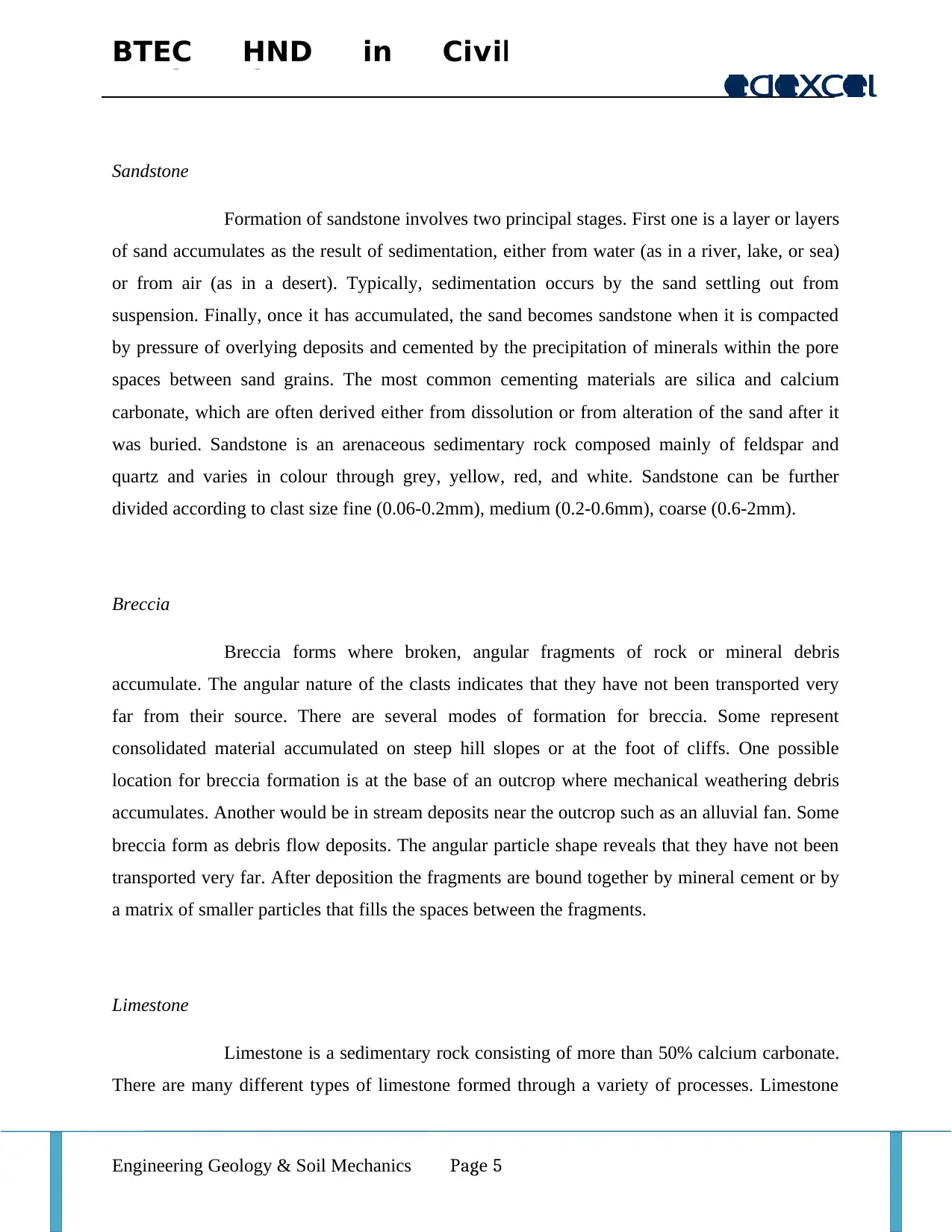
BTEC HND in Civil
Engineering
Sandstone
Formation of sandstone involves two principal stages. First one is a layer or layers
of sand accumulates as the result of sedimentation, either from water (as in a river, lake, or sea)
or from air (as in a desert). Typically, sedimentation occurs by the sand settling out from
suspension. Finally, once it has accumulated, the sand becomes sandstone when it is compacted
by pressure of overlying deposits and cemented by the precipitation of minerals within the pore
spaces between sand grains. The most common cementing materials are silica and calcium
carbonate, which are often derived either from dissolution or from alteration of the sand after it
was buried. Sandstone is an arenaceous sedimentary rock composed mainly of feldspar and
quartz and varies in colour through grey, yellow, red, and white. Sandstone can be further
divided according to clast size fine (0.06-0.2mm), medium (0.2-0.6mm), coarse (0.6-2mm).
Breccia
Breccia forms where broken, angular fragments of rock or mineral debris
accumulate. The angular nature of the clasts indicates that they have not been transported very
far from their source. There are several modes of formation for breccia. Some represent
consolidated material accumulated on steep hill slopes or at the foot of cliffs. One possible
location for breccia formation is at the base of an outcrop where mechanical weathering debris
accumulates. Another would be in stream deposits near the outcrop such as an alluvial fan. Some
breccia form as debris flow deposits. The angular particle shape reveals that they have not been
transported very far. After deposition the fragments are bound together by mineral cement or by
a matrix of smaller particles that fills the spaces between the fragments.
Limestone
Limestone is a sedimentary rock consisting of more than 50% calcium carbonate.
There are many different types of limestone formed through a variety of processes. Limestone
Engineering Geology & Soil Mechanics Page 5
Engineering
Sandstone
Formation of sandstone involves two principal stages. First one is a layer or layers
of sand accumulates as the result of sedimentation, either from water (as in a river, lake, or sea)
or from air (as in a desert). Typically, sedimentation occurs by the sand settling out from
suspension. Finally, once it has accumulated, the sand becomes sandstone when it is compacted
by pressure of overlying deposits and cemented by the precipitation of minerals within the pore
spaces between sand grains. The most common cementing materials are silica and calcium
carbonate, which are often derived either from dissolution or from alteration of the sand after it
was buried. Sandstone is an arenaceous sedimentary rock composed mainly of feldspar and
quartz and varies in colour through grey, yellow, red, and white. Sandstone can be further
divided according to clast size fine (0.06-0.2mm), medium (0.2-0.6mm), coarse (0.6-2mm).
Breccia
Breccia forms where broken, angular fragments of rock or mineral debris
accumulate. The angular nature of the clasts indicates that they have not been transported very
far from their source. There are several modes of formation for breccia. Some represent
consolidated material accumulated on steep hill slopes or at the foot of cliffs. One possible
location for breccia formation is at the base of an outcrop where mechanical weathering debris
accumulates. Another would be in stream deposits near the outcrop such as an alluvial fan. Some
breccia form as debris flow deposits. The angular particle shape reveals that they have not been
transported very far. After deposition the fragments are bound together by mineral cement or by
a matrix of smaller particles that fills the spaces between the fragments.
Limestone
Limestone is a sedimentary rock consisting of more than 50% calcium carbonate.
There are many different types of limestone formed through a variety of processes. Limestone
Engineering Geology & Soil Mechanics Page 5
⊘ This is a preview!⊘
Do you want full access?
Subscribe today to unlock all pages.

Trusted by 1+ million students worldwide
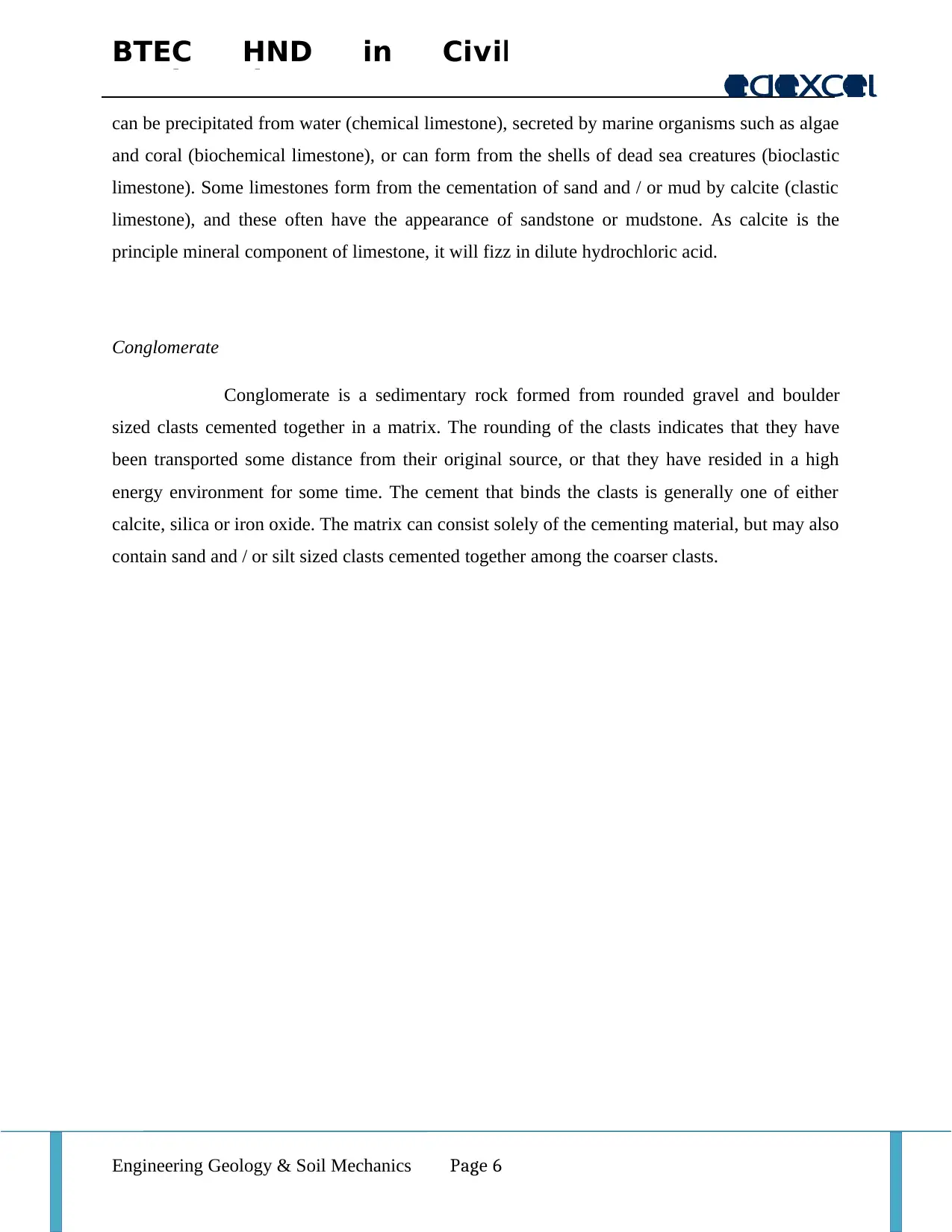
BTEC HND in Civil
Engineering
can be precipitated from water (chemical limestone), secreted by marine organisms such as algae
and coral (biochemical limestone), or can form from the shells of dead sea creatures (bioclastic
limestone). Some limestones form from the cementation of sand and / or mud by calcite (clastic
limestone), and these often have the appearance of sandstone or mudstone. As calcite is the
principle mineral component of limestone, it will fizz in dilute hydrochloric acid.
Conglomerate
Conglomerate is a sedimentary rock formed from rounded gravel and boulder
sized clasts cemented together in a matrix. The rounding of the clasts indicates that they have
been transported some distance from their original source, or that they have resided in a high
energy environment for some time. The cement that binds the clasts is generally one of either
calcite, silica or iron oxide. The matrix can consist solely of the cementing material, but may also
contain sand and / or silt sized clasts cemented together among the coarser clasts.
Engineering Geology & Soil Mechanics Page 6
Engineering
can be precipitated from water (chemical limestone), secreted by marine organisms such as algae
and coral (biochemical limestone), or can form from the shells of dead sea creatures (bioclastic
limestone). Some limestones form from the cementation of sand and / or mud by calcite (clastic
limestone), and these often have the appearance of sandstone or mudstone. As calcite is the
principle mineral component of limestone, it will fizz in dilute hydrochloric acid.
Conglomerate
Conglomerate is a sedimentary rock formed from rounded gravel and boulder
sized clasts cemented together in a matrix. The rounding of the clasts indicates that they have
been transported some distance from their original source, or that they have resided in a high
energy environment for some time. The cement that binds the clasts is generally one of either
calcite, silica or iron oxide. The matrix can consist solely of the cementing material, but may also
contain sand and / or silt sized clasts cemented together among the coarser clasts.
Engineering Geology & Soil Mechanics Page 6
Paraphrase This Document
Need a fresh take? Get an instant paraphrase of this document with our AI Paraphraser
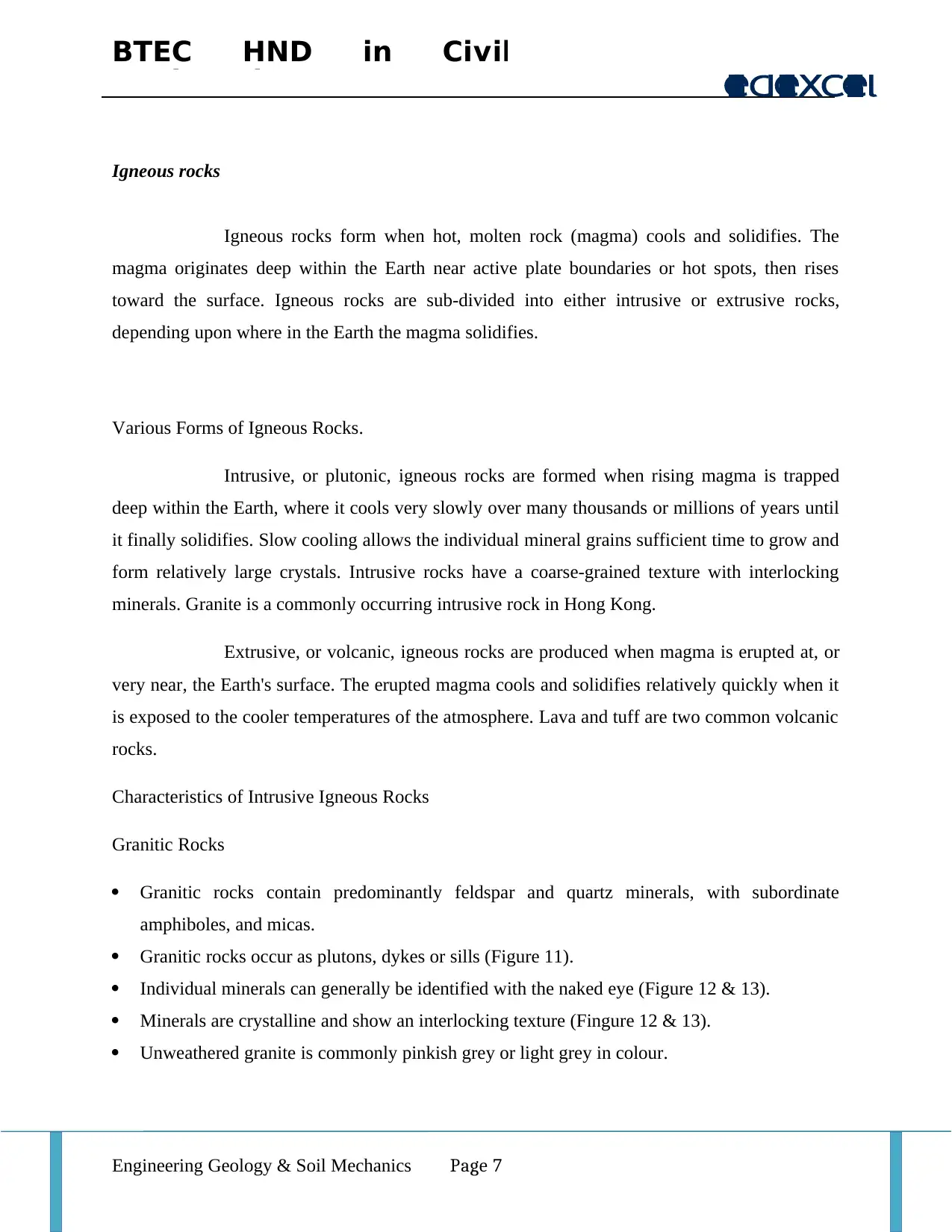
BTEC HND in Civil
Engineering
Igneous rocks
Igneous rocks form when hot, molten rock (magma) cools and solidifies. The
magma originates deep within the Earth near active plate boundaries or hot spots, then rises
toward the surface. Igneous rocks are sub-divided into either intrusive or extrusive rocks,
depending upon where in the Earth the magma solidifies.
Various Forms of Igneous Rocks.
Intrusive, or plutonic, igneous rocks are formed when rising magma is trapped
deep within the Earth, where it cools very slowly over many thousands or millions of years until
it finally solidifies. Slow cooling allows the individual mineral grains sufficient time to grow and
form relatively large crystals. Intrusive rocks have a coarse-grained texture with interlocking
minerals. Granite is a commonly occurring intrusive rock in Hong Kong.
Extrusive, or volcanic, igneous rocks are produced when magma is erupted at, or
very near, the Earth's surface. The erupted magma cools and solidifies relatively quickly when it
is exposed to the cooler temperatures of the atmosphere. Lava and tuff are two common volcanic
rocks.
Characteristics of Intrusive Igneous Rocks
Granitic Rocks
Granitic rocks contain predominantly feldspar and quartz minerals, with subordinate
amphiboles, and micas.
Granitic rocks occur as plutons, dykes or sills (Figure 11).
Individual minerals can generally be identified with the naked eye (Figure 12 & 13).
Minerals are crystalline and show an interlocking texture (Fingure 12 & 13).
Unweathered granite is commonly pinkish grey or light grey in colour.
Engineering Geology & Soil Mechanics Page 7
Engineering
Igneous rocks
Igneous rocks form when hot, molten rock (magma) cools and solidifies. The
magma originates deep within the Earth near active plate boundaries or hot spots, then rises
toward the surface. Igneous rocks are sub-divided into either intrusive or extrusive rocks,
depending upon where in the Earth the magma solidifies.
Various Forms of Igneous Rocks.
Intrusive, or plutonic, igneous rocks are formed when rising magma is trapped
deep within the Earth, where it cools very slowly over many thousands or millions of years until
it finally solidifies. Slow cooling allows the individual mineral grains sufficient time to grow and
form relatively large crystals. Intrusive rocks have a coarse-grained texture with interlocking
minerals. Granite is a commonly occurring intrusive rock in Hong Kong.
Extrusive, or volcanic, igneous rocks are produced when magma is erupted at, or
very near, the Earth's surface. The erupted magma cools and solidifies relatively quickly when it
is exposed to the cooler temperatures of the atmosphere. Lava and tuff are two common volcanic
rocks.
Characteristics of Intrusive Igneous Rocks
Granitic Rocks
Granitic rocks contain predominantly feldspar and quartz minerals, with subordinate
amphiboles, and micas.
Granitic rocks occur as plutons, dykes or sills (Figure 11).
Individual minerals can generally be identified with the naked eye (Figure 12 & 13).
Minerals are crystalline and show an interlocking texture (Fingure 12 & 13).
Unweathered granite is commonly pinkish grey or light grey in colour.
Engineering Geology & Soil Mechanics Page 7
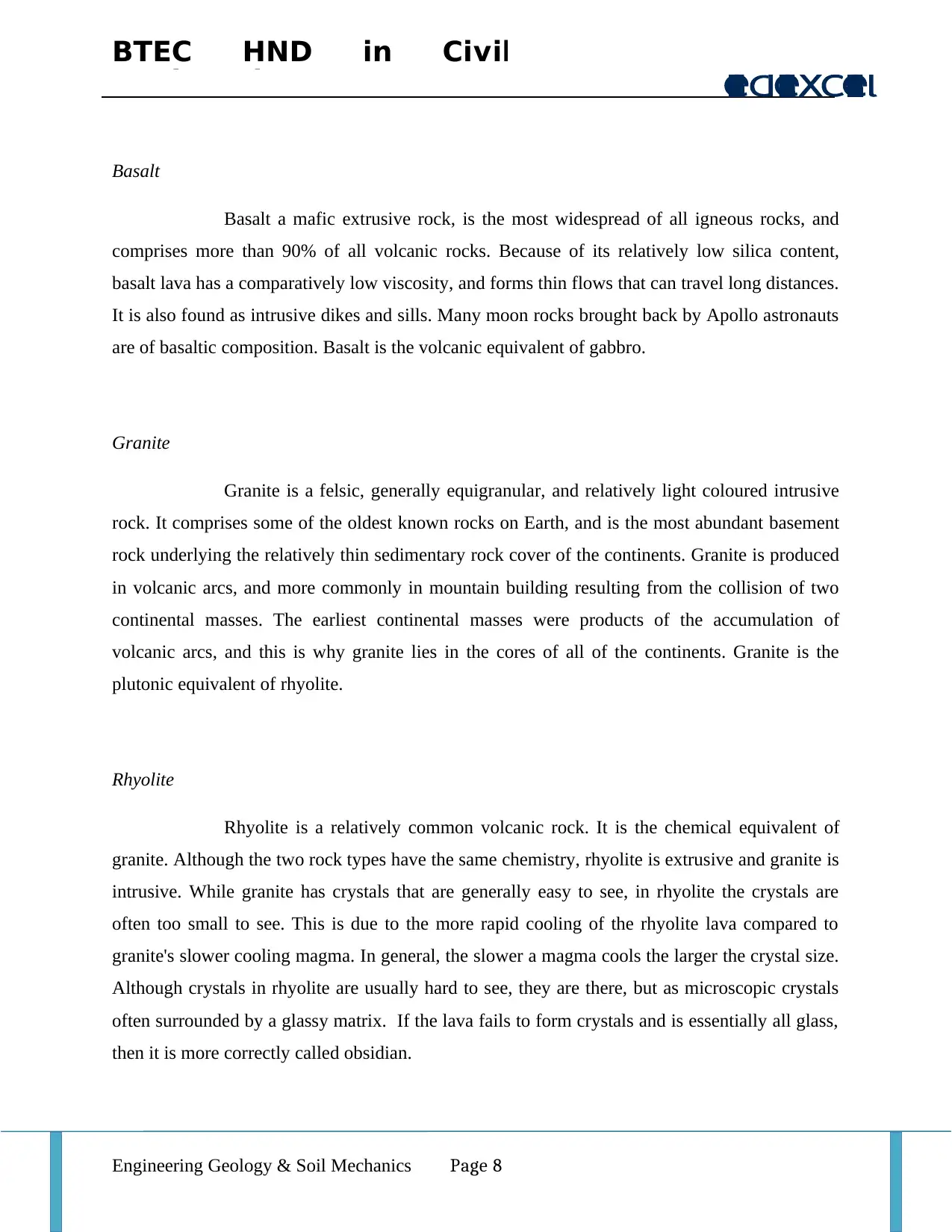
BTEC HND in Civil
Engineering
Basalt
Basalt a mafic extrusive rock, is the most widespread of all igneous rocks, and
comprises more than 90% of all volcanic rocks. Because of its relatively low silica content,
basalt lava has a comparatively low viscosity, and forms thin flows that can travel long distances.
It is also found as intrusive dikes and sills. Many moon rocks brought back by Apollo astronauts
are of basaltic composition. Basalt is the volcanic equivalent of gabbro.
Granite
Granite is a felsic, generally equigranular, and relatively light coloured intrusive
rock. It comprises some of the oldest known rocks on Earth, and is the most abundant basement
rock underlying the relatively thin sedimentary rock cover of the continents. Granite is produced
in volcanic arcs, and more commonly in mountain building resulting from the collision of two
continental masses. The earliest continental masses were products of the accumulation of
volcanic arcs, and this is why granite lies in the cores of all of the continents. Granite is the
plutonic equivalent of rhyolite.
Rhyolite
Rhyolite is a relatively common volcanic rock. It is the chemical equivalent of
granite. Although the two rock types have the same chemistry, rhyolite is extrusive and granite is
intrusive. While granite has crystals that are generally easy to see, in rhyolite the crystals are
often too small to see. This is due to the more rapid cooling of the rhyolite lava compared to
granite's slower cooling magma. In general, the slower a magma cools the larger the crystal size.
Although crystals in rhyolite are usually hard to see, they are there, but as microscopic crystals
often surrounded by a glassy matrix. If the lava fails to form crystals and is essentially all glass,
then it is more correctly called obsidian.
Engineering Geology & Soil Mechanics Page 8
Engineering
Basalt
Basalt a mafic extrusive rock, is the most widespread of all igneous rocks, and
comprises more than 90% of all volcanic rocks. Because of its relatively low silica content,
basalt lava has a comparatively low viscosity, and forms thin flows that can travel long distances.
It is also found as intrusive dikes and sills. Many moon rocks brought back by Apollo astronauts
are of basaltic composition. Basalt is the volcanic equivalent of gabbro.
Granite
Granite is a felsic, generally equigranular, and relatively light coloured intrusive
rock. It comprises some of the oldest known rocks on Earth, and is the most abundant basement
rock underlying the relatively thin sedimentary rock cover of the continents. Granite is produced
in volcanic arcs, and more commonly in mountain building resulting from the collision of two
continental masses. The earliest continental masses were products of the accumulation of
volcanic arcs, and this is why granite lies in the cores of all of the continents. Granite is the
plutonic equivalent of rhyolite.
Rhyolite
Rhyolite is a relatively common volcanic rock. It is the chemical equivalent of
granite. Although the two rock types have the same chemistry, rhyolite is extrusive and granite is
intrusive. While granite has crystals that are generally easy to see, in rhyolite the crystals are
often too small to see. This is due to the more rapid cooling of the rhyolite lava compared to
granite's slower cooling magma. In general, the slower a magma cools the larger the crystal size.
Although crystals in rhyolite are usually hard to see, they are there, but as microscopic crystals
often surrounded by a glassy matrix. If the lava fails to form crystals and is essentially all glass,
then it is more correctly called obsidian.
Engineering Geology & Soil Mechanics Page 8
⊘ This is a preview!⊘
Do you want full access?
Subscribe today to unlock all pages.

Trusted by 1+ million students worldwide
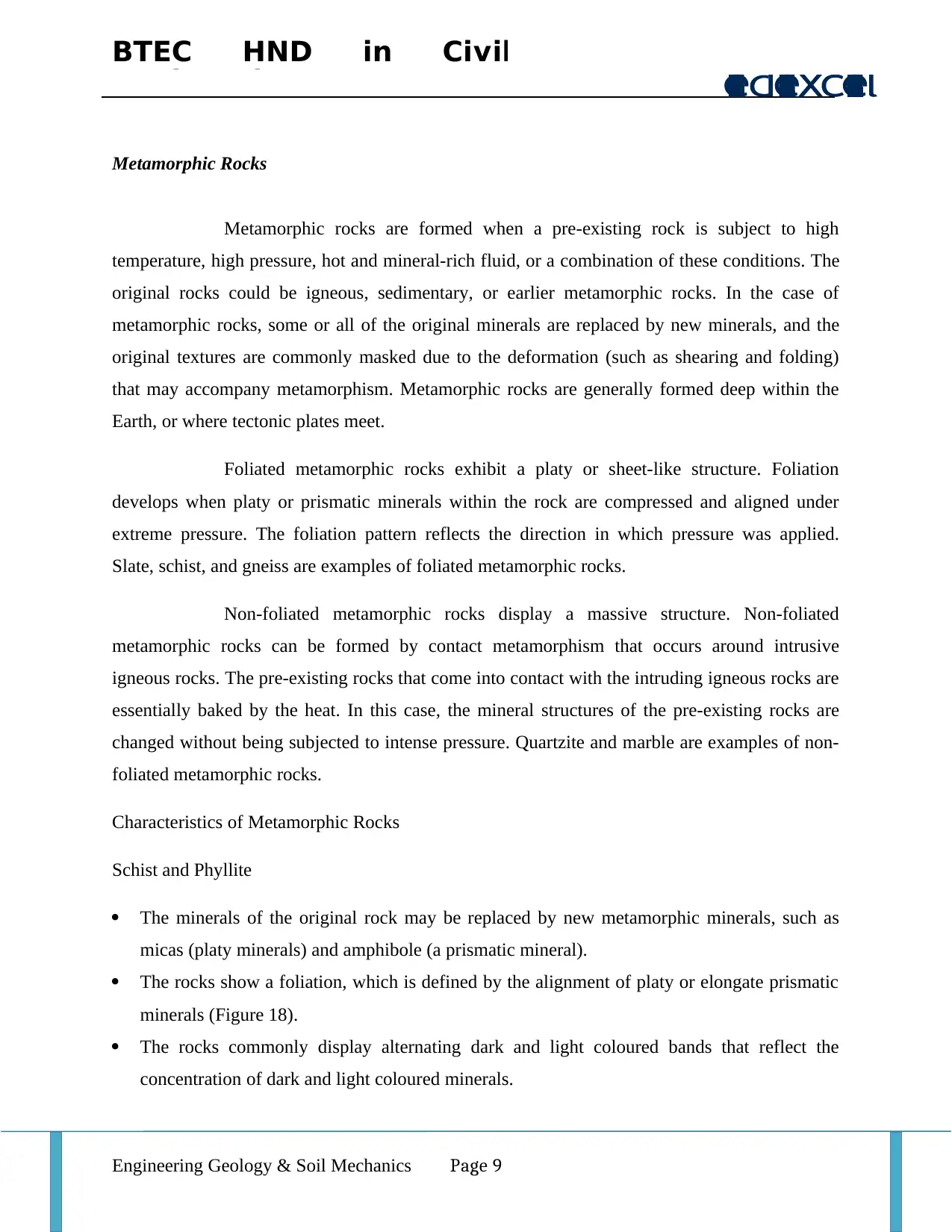
BTEC HND in Civil
Engineering
Metamorphic Rocks
Metamorphic rocks are formed when a pre-existing rock is subject to high
temperature, high pressure, hot and mineral-rich fluid, or a combination of these conditions. The
original rocks could be igneous, sedimentary, or earlier metamorphic rocks. In the case of
metamorphic rocks, some or all of the original minerals are replaced by new minerals, and the
original textures are commonly masked due to the deformation (such as shearing and folding)
that may accompany metamorphism. Metamorphic rocks are generally formed deep within the
Earth, or where tectonic plates meet.
Foliated metamorphic rocks exhibit a platy or sheet-like structure. Foliation
develops when platy or prismatic minerals within the rock are compressed and aligned under
extreme pressure. The foliation pattern reflects the direction in which pressure was applied.
Slate, schist, and gneiss are examples of foliated metamorphic rocks.
Non-foliated metamorphic rocks display a massive structure. Non-foliated
metamorphic rocks can be formed by contact metamorphism that occurs around intrusive
igneous rocks. The pre-existing rocks that come into contact with the intruding igneous rocks are
essentially baked by the heat. In this case, the mineral structures of the pre-existing rocks are
changed without being subjected to intense pressure. Quartzite and marble are examples of non-
foliated metamorphic rocks.
Characteristics of Metamorphic Rocks
Schist and Phyllite
The minerals of the original rock may be replaced by new metamorphic minerals, such as
micas (platy minerals) and amphibole (a prismatic mineral).
The rocks show a foliation, which is defined by the alignment of platy or elongate prismatic
minerals (Figure 18).
The rocks commonly display alternating dark and light coloured bands that reflect the
concentration of dark and light coloured minerals.
Engineering Geology & Soil Mechanics Page 9
Engineering
Metamorphic Rocks
Metamorphic rocks are formed when a pre-existing rock is subject to high
temperature, high pressure, hot and mineral-rich fluid, or a combination of these conditions. The
original rocks could be igneous, sedimentary, or earlier metamorphic rocks. In the case of
metamorphic rocks, some or all of the original minerals are replaced by new minerals, and the
original textures are commonly masked due to the deformation (such as shearing and folding)
that may accompany metamorphism. Metamorphic rocks are generally formed deep within the
Earth, or where tectonic plates meet.
Foliated metamorphic rocks exhibit a platy or sheet-like structure. Foliation
develops when platy or prismatic minerals within the rock are compressed and aligned under
extreme pressure. The foliation pattern reflects the direction in which pressure was applied.
Slate, schist, and gneiss are examples of foliated metamorphic rocks.
Non-foliated metamorphic rocks display a massive structure. Non-foliated
metamorphic rocks can be formed by contact metamorphism that occurs around intrusive
igneous rocks. The pre-existing rocks that come into contact with the intruding igneous rocks are
essentially baked by the heat. In this case, the mineral structures of the pre-existing rocks are
changed without being subjected to intense pressure. Quartzite and marble are examples of non-
foliated metamorphic rocks.
Characteristics of Metamorphic Rocks
Schist and Phyllite
The minerals of the original rock may be replaced by new metamorphic minerals, such as
micas (platy minerals) and amphibole (a prismatic mineral).
The rocks show a foliation, which is defined by the alignment of platy or elongate prismatic
minerals (Figure 18).
The rocks commonly display alternating dark and light coloured bands that reflect the
concentration of dark and light coloured minerals.
Engineering Geology & Soil Mechanics Page 9
Paraphrase This Document
Need a fresh take? Get an instant paraphrase of this document with our AI Paraphraser
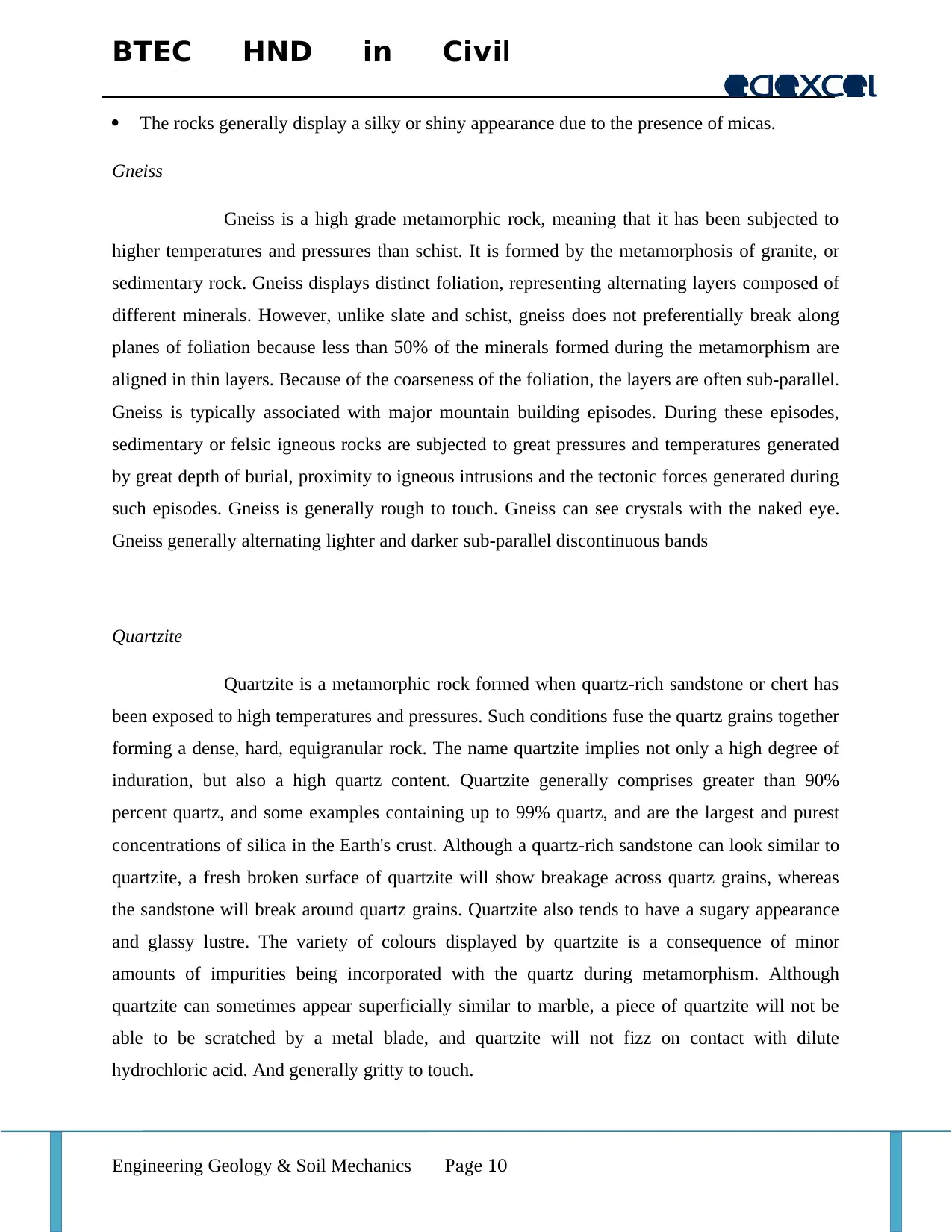
BTEC HND in Civil
Engineering
The rocks generally display a silky or shiny appearance due to the presence of micas.
Gneiss
Gneiss is a high grade metamorphic rock, meaning that it has been subjected to
higher temperatures and pressures than schist. It is formed by the metamorphosis of granite, or
sedimentary rock. Gneiss displays distinct foliation, representing alternating layers composed of
different minerals. However, unlike slate and schist, gneiss does not preferentially break along
planes of foliation because less than 50% of the minerals formed during the metamorphism are
aligned in thin layers. Because of the coarseness of the foliation, the layers are often sub-parallel.
Gneiss is typically associated with major mountain building episodes. During these episodes,
sedimentary or felsic igneous rocks are subjected to great pressures and temperatures generated
by great depth of burial, proximity to igneous intrusions and the tectonic forces generated during
such episodes. Gneiss is generally rough to touch. Gneiss can see crystals with the naked eye.
Gneiss generally alternating lighter and darker sub-parallel discontinuous bands
Quartzite
Quartzite is a metamorphic rock formed when quartz-rich sandstone or chert has
been exposed to high temperatures and pressures. Such conditions fuse the quartz grains together
forming a dense, hard, equigranular rock. The name quartzite implies not only a high degree of
induration, but also a high quartz content. Quartzite generally comprises greater than 90%
percent quartz, and some examples containing up to 99% quartz, and are the largest and purest
concentrations of silica in the Earth's crust. Although a quartz-rich sandstone can look similar to
quartzite, a fresh broken surface of quartzite will show breakage across quartz grains, whereas
the sandstone will break around quartz grains. Quartzite also tends to have a sugary appearance
and glassy lustre. The variety of colours displayed by quartzite is a consequence of minor
amounts of impurities being incorporated with the quartz during metamorphism. Although
quartzite can sometimes appear superficially similar to marble, a piece of quartzite will not be
able to be scratched by a metal blade, and quartzite will not fizz on contact with dilute
hydrochloric acid. And generally gritty to touch.
Engineering Geology & Soil Mechanics Page 10
Engineering
The rocks generally display a silky or shiny appearance due to the presence of micas.
Gneiss
Gneiss is a high grade metamorphic rock, meaning that it has been subjected to
higher temperatures and pressures than schist. It is formed by the metamorphosis of granite, or
sedimentary rock. Gneiss displays distinct foliation, representing alternating layers composed of
different minerals. However, unlike slate and schist, gneiss does not preferentially break along
planes of foliation because less than 50% of the minerals formed during the metamorphism are
aligned in thin layers. Because of the coarseness of the foliation, the layers are often sub-parallel.
Gneiss is typically associated with major mountain building episodes. During these episodes,
sedimentary or felsic igneous rocks are subjected to great pressures and temperatures generated
by great depth of burial, proximity to igneous intrusions and the tectonic forces generated during
such episodes. Gneiss is generally rough to touch. Gneiss can see crystals with the naked eye.
Gneiss generally alternating lighter and darker sub-parallel discontinuous bands
Quartzite
Quartzite is a metamorphic rock formed when quartz-rich sandstone or chert has
been exposed to high temperatures and pressures. Such conditions fuse the quartz grains together
forming a dense, hard, equigranular rock. The name quartzite implies not only a high degree of
induration, but also a high quartz content. Quartzite generally comprises greater than 90%
percent quartz, and some examples containing up to 99% quartz, and are the largest and purest
concentrations of silica in the Earth's crust. Although a quartz-rich sandstone can look similar to
quartzite, a fresh broken surface of quartzite will show breakage across quartz grains, whereas
the sandstone will break around quartz grains. Quartzite also tends to have a sugary appearance
and glassy lustre. The variety of colours displayed by quartzite is a consequence of minor
amounts of impurities being incorporated with the quartz during metamorphism. Although
quartzite can sometimes appear superficially similar to marble, a piece of quartzite will not be
able to be scratched by a metal blade, and quartzite will not fizz on contact with dilute
hydrochloric acid. And generally gritty to touch.
Engineering Geology & Soil Mechanics Page 10

BTEC HND in Civil
Engineering
Engineering Geology & Soil Mechanics Page 11
Engineering
Engineering Geology & Soil Mechanics Page 11
⊘ This is a preview!⊘
Do you want full access?
Subscribe today to unlock all pages.

Trusted by 1+ million students worldwide
1 out of 20
Your All-in-One AI-Powered Toolkit for Academic Success.
+13062052269
info@desklib.com
Available 24*7 on WhatsApp / Email
![[object Object]](/_next/static/media/star-bottom.7253800d.svg)
Unlock your academic potential
Copyright © 2020–2025 A2Z Services. All Rights Reserved. Developed and managed by ZUCOL.

